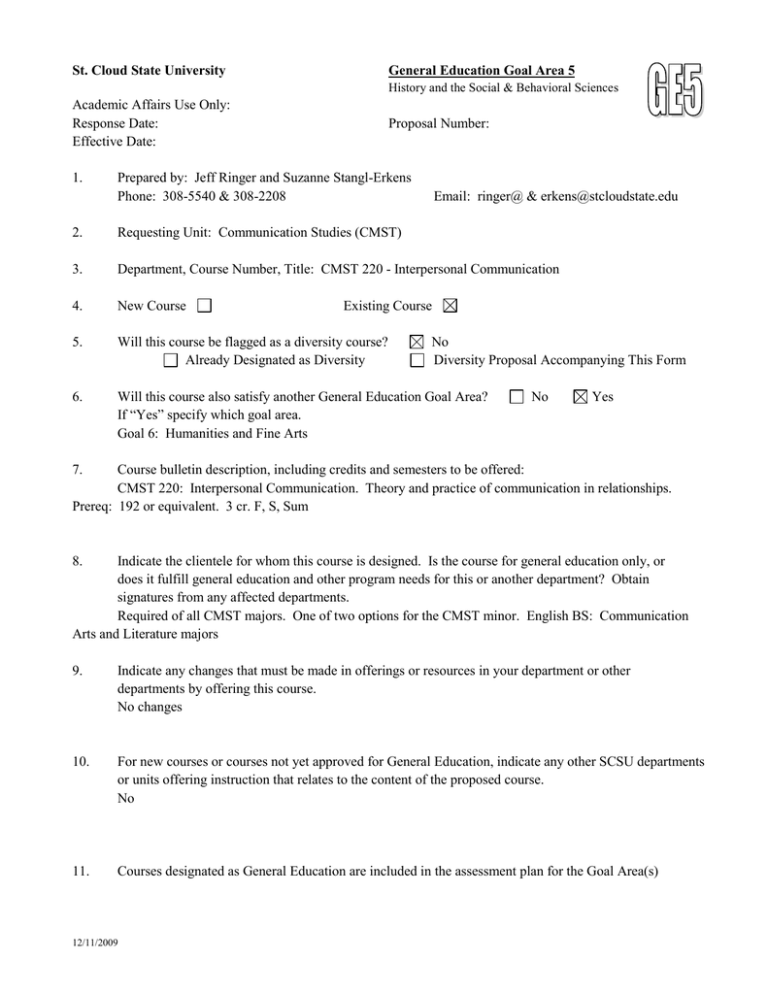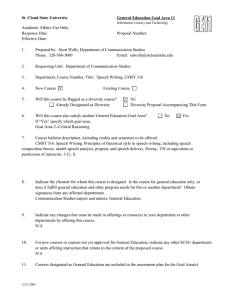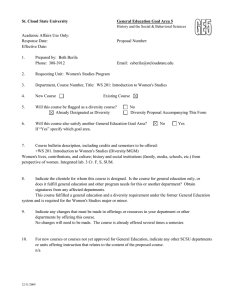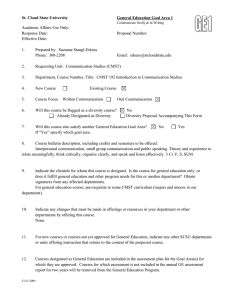Academic Affairs Use Only: Response Date: Proposal Number:
advertisement

St. Cloud State University General Education Goal Area 5 History and the Social & Behavioral Sciences Academic Affairs Use Only: Response Date: Effective Date: 1. Proposal Number: Prepared by: Jeff Ringer and Suzanne Stangl-Erkens Phone: 308-5540 & 308-2208 Email: ringer@ & erkens@stcloudstate.edu 2. Requesting Unit: Communication Studies (CMST) 3. Department, Course Number, Title: CMST 220 - Interpersonal Communication 4. New Course 5. Will this course be flagged as a diversity course? Already Designated as Diversity 6. Will this course also satisfy another General Education Goal Area? If “Yes” specify which goal area. Goal 6: Humanities and Fine Arts Existing Course No Diversity Proposal Accompanying This Form No Yes 7. Course bulletin description, including credits and semesters to be offered: CMST 220: Interpersonal Communication. Theory and practice of communication in relationships. Prereq: 192 or equivalent. 3 cr. F, S, Sum 8. Indicate the clientele for whom this course is designed. Is the course for general education only, or does it fulfill general education and other program needs for this or another department? Obtain signatures from any affected departments. Required of all CMST majors. One of two options for the CMST minor. English BS: Communication Arts and Literature majors 9. Indicate any changes that must be made in offerings or resources in your department or other departments by offering this course. No changes 10. For new courses or courses not yet approved for General Education, indicate any other SCSU departments or units offering instruction that relates to the content of the proposed course. No 11. Courses designated as General Education are included in the assessment plan for the Goal Area(s) 12/11/2009 for which they are approved. Courses for which assessment is not included in the annual GE assessment report for two years will be removed from the General Education Program. The Requesting Unit understands and recognizes the above conditions. 12. Provide a concise explanation of how the following goal is a “significant focus” of the proposed course. Goal Area 5: History and the Social & Behavioral Sciences Develop understanding of human societies and behaviors, and of the concepts, theories, and methods of history and the social sciences. The interpersonal communication course examines the ways human beings produce and reproduce personal and social relationships through talk and interaction. The research upon which this course is built has historically been conducted using social scientific methods of inquiry. The students examine the results of this research as they study and practice various interpersonal theories and skills. 13. In order for a course to be designated as fulfilling Goal Area 5, it must address at least 4 of the 5 student learning outcomes (SLOs) below. Check the SLOs below that are focused on in the proposed general education course. 1. Describe or use the methods and data by which historians, social scientists, or behavioral scientists investigate human conditions. 2. Analyze human behavior, cultures, and social institutions and processes from the perspectives of history or the social and behavioral sciences. 3. Develop explanations for and explore solutions to historical or contemporary social problems. 4. Reflect upon themselves in relation to family, communities, society, culture, and/or their histories. 5. Apply and critique alternative explanatory systems or theories about human societies and behaviors. 14. Discuss how each Student Learning Outcome checked above is achieved in this course. (Note: Although descriptions of typical assignments or types of assignments may be part of this discussion, it is not appropriate to submit copies of actual assignments.) 1. Students will study and apply interpersonal theories and research methods used by historians, social scientists, and behavioral scientists who have contributed to the field of Communication Studies, specifically interpersonal communication. They will achieve this through discussion, role plays, analysis papers, and skill development. 2. Students will analyze human behavior (conversation between two people), cultures (how culture shapes and is shaped by communication), and social institutions (relationships, the family, the workplace) and processes (conversation, conflict management) from the perspective of a social science - communication. 3. Students will develop explanations for and explore solutions to contemporary social problems such as dysfunctional social discourse, conflict in relationships and families, conflict in workplace relationships. 4. Students will reflect upon themselves in relation to family, communities, society, culture, and/or their histories as they analyze how communication both shapes and are shaped by those contexts. Students learn basic communication processes (such as listening, conversation, conflict management) and study how those processes shape the family and are shaped by the family. They study how those processes both shape and are shaped by the communities and cultures in which they live. 12/11/2009 5. Students will apply and critique alternative explanatory systems or theories about human societies and behaviors through the study and application of alternative/diverse interpersonal theories and contexts. They will achieve this primarily through class discussion and research/analysis papers. 15. List or attach the Course Outline (adequately described and including percentage of time to be allocated to each topic). Curriculum Committees may request additional information. Topics larger than 20% need to be broken down further. Indicate in your course outline where the Student Learning Outcomes checked above are being met. 1. Communication processes and theoretical perspectives (SLO 1) a. Language 5% b. Nonverbal communication 5% c. Identity/self-concept 5% d. Self-disclosure 5% e. Perception 5% 2. Communication and relationships (SLO 2, 3, 4) a. How communication shapes relationships and is shaped by relationships 10% b. Communication as relationships develop 5% c. Communication as relationships are maintained 5% d. Communication as relationships deteriorate 5% 3. Contexts (SLO 2, 4) a. Gender 5% b. Culture 5% c. Age 5% d. Family 5% e. Work 5% 4. Communication episodes (SLO 2, 4) a. How communication shapes and is shaped by episodes 5% b. Conflict 5% c. Listening 5% d. Conversation 5% e. Climate 5% 12/11/2009 St. Cloud State University General Education Transmittal Form Academic Affairs Use Only: Response Date: Effective Date: Proposal Number Department: Communication Studies CMST Course or Course(s): CMST 220 - Interpersonal Communication Roseanna Gaye Ross Department or Unit Chair Signature 2/05/10 Date Department forward to Academic Affairs for publication and electronically to Chair of General Education Committee, Chair of College Curriculum Committee, College Dean Recommendation of General Education Committee: Approve Remarks: Disapprove Chairperson Committee Signature Date Recommendation of University Curriculum Committee: Approve Remarks: Disapprove Chairperson Committee Signature Date Recommendation of Faculty Association: Approve Remarks: Disapprove FA Senate Signature Date Action of Academic Vice President: Approve Disapprove Signature Entered in Curriculum Data File 12/11/2009 Remarks: Date


